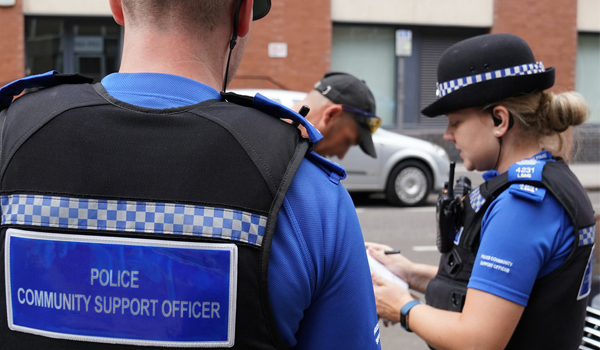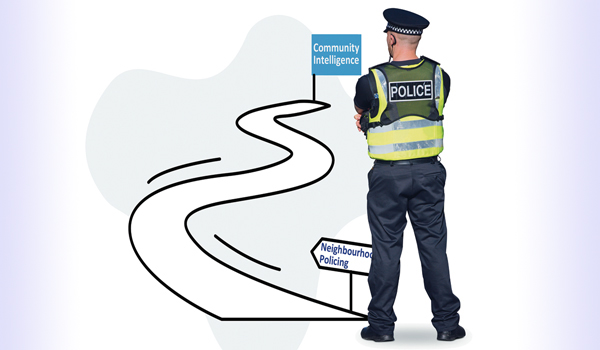Tackling VAWG through community intelligence
Steve Dodd provides an insight into the criminality that is violence against women and girls, one that the Government has pledged to halve over the next ten years.
In an unprecedented joint intervention, the Victims’ Commissioner and Domestic Abuse Commissioner wrote to the Prime Minister in June warning he is at risk of missing his flagship target to halve violence against women and girls (VAWG) unless urgent investment is made in victim support services.
Baroness Newlove, Victims’ Commissioner for England and Wales, and Dame Nicole Jacobs, the Domestic Abuse Commissioner, said they were “increasingly concerned” that the Government’s response to the epidemic levels of abuse is following the same “piecemeal” pattern as before (https://victimscommissioner.org.uk/news/pm-warned-he-will-miss-target-to-halve-violence-against-women-without-urgent-investment/).
The elevation of VAWG to the status of a Strategic Policing Requirement (SPR) alongside terrorism, serious and organised crime, and child abuse and exploitation, is a clear indication the threat this criminality poses to civil society.
The Home Office’s SPR, covers seven areas the Home Secretary consider the biggest threats to public safety; the 2023 SPR included VAWG for the first time as a national threat.
The Home Office Police Standards and Performance Improvement Directorate (HOPSPID) has written a framework incorporating a ‘Theory of Change’ devised to clarify how the Neighbourhood Policing Guarantee supports the Government’s Safer Streets Mission. It is accompanied by a performance framework set to gauge its effectiveness. Results-oriented policing will appear in many guises; success will be judged across many a conflicting criterion.
Its statutory background requires policing to implement the five pillars of the Theory of Change through the College of Policing’s neighbourhood policing guidelines. This article backs an opinion proposing support for officers through the application of a community intelligence-led protocol for the reason that the burden of responsibility placed at the door of neighbourhood policing is overladen with expectation and fraught with complication.
Forewarning and forearming are only part of the preparation; clarification, awareness and confidence are paramount for the officers who are to be the public face of policing as we enter the second half of the 21st century.
Professionalising community officer designation via the Neighbourhood Policing Pathway (NPP) is a positive step on the road to development of the service; universal acknowledgement of NPP as a specialism will promote camaraderie through team ethos, which will provide psychological support for the individual, enhanced standing within the police service and I contest, also a degree of kudos as wellbeing is an important consideration in backing neighbourhood officers.
A neighbourhood officer’s beat will include victims, survivors and families of the 5,364,061 recorded crimes committed in 2024, plus, those of every previous year and those awaiting to be designated for the current period. This is no insignificant a number, likewise this introduction is a cautionary notice for rank-and-file officers though I am sure there is already familiarity with Operation Soteria.
The Home Office’s SPR adopted in each force’s strategic review will ensure the implementation of the five Pillars principles where Pillar 2 states: “Community-led policing: A named, contactable officer for every neighbourhood, responsive to local problems. Residents and local businesses will be able to have a say on the police’s priorities for their area.”
This is a requirement that will afford greater opportunity for residents to become acquainted with their designated contact, fostering trust and building rapport. It is intended to lay the foundation for improved bilateral communication, the public having authority by consent, the police obtaining information for their evidence-based approach.
An additional intended benefit for neighbourhood policing is one of recognition, for the NPP is redefining the community work of beat officers. Responsibility speaking, risk will invariably be a neighbourhood officer’s judgment to make at the initial point of contact if the victim’s approach is not a telephone report or an electronic submission.
The reality facing policing is monumental. The HOPSPID has announced a performance framework to gauge the 43 forces effectiveness. Scrutiny will be commensurate with the task; an assurance devised to clarify how successfully the police are applying the Neighbourhood Policing Guarantee, which implements the Government’s Safer Streets Mission.
Protecting, preventing and prosecuting those crimes committed against females is further complicated by a number of factors, as illustrated by the fact that the police definition differs substantively from the Home Office version in that it only applying to females. The issue of data recording was also identified by the Home Secretary in her speech and as a result a new performance management framework will be mandatorily introduced for police forces.
The subjugation of women is as ancient as history itself; the application of community intelligence-led policing to chronicle instances of gender-based violence and misogynistic abuse of women is temporal. The crimes of forced marriage, female genital mutilation, ‘honour’ killings, domestic abuse, stalking, sexual assaults and rape are exponentially magnified by increasing methods of technology-enabled criminality and online abuses facilitated in the metaverse.
Domestic abuse is defined in law as the physical, emotional, psychological, sexual or economic abuse by a current or former partner or someone with a family-type connection (National Centre for Domestic Violence). https://www.ncdv.org.uk/what-is-domestic-abuse-violence/
Accumulated effects are not directly exposed by the repetition of producing statistics; each of these numbers is an individual person in their own right having family members, neighbours, friends, colleagues, acquaintances. Police recorded 851,062 domestic abuse -related crimes in the year to March 2024 on top of the 911,248 for the previous 12 months. The Office for National Statistics’ latest crime survey estimated that 2,300,000 people aged 16 years and over experienced domestic abuse in the same period; a figure comprised of 1,600,000 women and 712,000 male victims.
The Advocacy After Fatal Domestic Abuse (AAFDA) and the University of Warwick produced a policy brief – An Analysis of Domestic Homicide Reviews in Cases of Domestic Abuse Suicide – which said: “These victims were often struggling in plain sight of services.”
It further concluded: “Our data gives clear insight regarding risks associated with suicide, which are often intrinsically linked to victims’ experiences of being ‘ground down’, both by long periods of abuse/control and by systemic failures across services to address that abuse and victims’ associated vulnerabilities” (https://aafda.org.uk/learning-legacies).
I recently had a conversation with a social worker from Manchester who was at pains to explain how they provide practical support and pragmatic advice along the lines of self-preservation, with exit strategies designed to save the lives of their female clients, yet no such equivalent support structures exist to aid their male assailants.
Innovative legislation evidences the immediate need for expansion of the Home Office and Ministry of Justice’s pilot on Domestic Abuse Protection Orders (DAPOs). The arrangement between Greater Manchester Police and a dedicated team at Manchester and Salford Magistrates’ Court has secured more than 200 DAPOs in the first six months of the trial’s existence.
Detective Superintendent Jen Tattersall, force lead for domestic abuse, is quoted on GMP’s website: “We have seen both male and female victims protected with these orders, from partners, ex-partners, or family members, and have been able to essentially ‘tailor-make’ orders to suit individual circumstances and needs, reflecting the patterns and histories of abuse leading to a protective order being required.
“Charities and other partners have also been engaged in the pilot and supporting several victims who are not supportive of police action but still need that protection to apply for orders themselves via the family courts…” (https://www.gmp.police.uk/news/greater-manchester/news/news/2025/june/domestic-abuse-protection-orders-pilot–over-200-orders-secured-in-first-six-months/)
The College of Policing’s Authorised Professional Practice’s guideline definition is: “Intelligence is collected information that has been developed for action. The heterogenous material of community intelligence’s recorded data is protected by the legal basis of policing purpose.”
Community Intelligence-Led Policing Methodology (CILPM) is a pragmatic approach to the management of local information by community officers recording material relevant to important local concerns and safety of individuals.
I describe CILPM as thin layers of data used as intelligence. The machination of everyday life crosses the paths of criminality and victims alike; community officers undertaking routine duties are also present in these scenarios consciously or subconsciously. CILPM obtains grassroots information at source, be it urban or rural enabling policing’s analytics, AI and its metaverse access to material not collected in the course of everyday policing informing force strategic tasking and coordination policies. For example, it is precisely the information Bedfordshire Police in conjunction with the Violence and Exploitation Prevention Partnership is requesting through its innovative ‘Lost Boys’ campaign. (https://www.beds.police.uk/news/bedfordshire/news/2025/06-june/police-launch-new-virtual-reality-film-to-help-save-lost-boys/)
Professor Alexis Jay OBE, author of the ‘Report of the Independent Inquiry into Child Sexual Assault’, informed the Home Affairs Select Committee in January this year that the average length of duration of sexual abuse a victim experiences is four years and the average time before disclosure is 26 years.
A Times Crime and Justice Commission report in April 2024 announced one in five homicides is domestic abuse, and that a woman is killed by a man every four days.
The Independent Inquiry for Child Sexual Abuse’s executive summary states, current estimates indicating that one in six girls experience child sexual abuse before the age of 16.
The Office for National Statistics estimates, 3,100,000 adults in England and Wales had experienced sexual abuse before the age of 16.
The Crime Survey for England and Wales suggests there is a significant under-reporting of sexual offences with only one in six victims of rape going to the police, a sobering figure as in the year ending June 2024, police forces recorded 194,434 rape and serious sexual offences in England and Wales. The crime survey estimates that almost two million women in England and Wales have been the victim of rape at some point since the age of 16 and that 3,000,000 have experienced indecent exposure and 5,000,000 have suffered unwanted touching.
In the year ending June 2024, police recorded 620,861 offences of stalking and harassment; up from 436,196 in March 2023. Note, this is for the complete crime – how many times is this to be multiplied to capture the number of people who are suffering indignity and abuse every single day of the week but as yet do not qualify as the full offence?
Protect and Prevent: The Policing Vision 2025 authored by the Association of Police and Crime Commissioners in conjunction with the National Police Chiefs’ Council (NPCC), sets out its plan for the next decade where transformation is key to the vision.
Reticence to separate VAWG from serious and organised crime is acknowledged as domestic abuse and child sexual exploitation stand out clearly in the strategic overview, with collaboration central to the vision – as it is with the tenet of the SPR. (https://assets.publishing.service.gov.uk/media/64955fb9de8682000cbc8cf0/Strategic_Policing_Requirement_V1.3.pdf)
Community intelligence-led policing is a practical manifestation of this ambition as forces are increasingly engaged collectively in interoperability projects as data sharing reinforces tailored local policing needs.
Intelligence opportunities are always to the fore, keep in mind the Vulnerability and Policing Futures, Research Centre’s findings: The findings show that police forces are changing how they consider, and process young people and vulnerable adults involved in drug markets. However, while they increasingly recognise vulnerability and investigate possible criminal exploitation, policing practice varies significantly between and even within forces. (https://vulnerabilitypolicing.org.uk/county-lines-policing-and-vulnerability/)
The Independent Inquiry for the Child Sexual Abuse’s (IICSA) executive summary says current estimates indicate that one in 20 boys experience child sexual abuse before the age of 16. (https://www.iicsa.org.uk/reports-recommendations/publications/inquiry/final-report/executive-summary.html)
IICSA recommendations are designed to ensure the spotlight remains on preventing child sexual abuse. Here again, the laminated thin layers of community intelligence, provenanced by the principle of ‘first account’ are records embedded in force’s electronic Record Management Systems, can be made available for interoperability partners and national intelligence requirements alike through CILPM.
Community intelligence and the opportunity to approach a neighbourhood officer is of paramount importance to officers cognisant of the IICSA report: In surveys, girls were at least three times as likely as boys to describe experiences of child sexual abuse. Disabled participants were twice as likely to describe such experiences as non-disabled participants, and those who lived in a care home were nearly four times as likely to have experienced child sexual abuse. Those who had experienced childhood neglect were nearly five times as likely to have experienced child sexual abuse as those who had not.
In the year up to May 2024 a joint NPCC and NCA Grooming Gangs Taskforce arrested 550 suspects and protected 4,000 victims against the Criminal Records Office official recorded national figures of 194,434 serious sexual offences.
On June 13, seven Rochdale men were found guilty of rape and assault at Manchester Minshull Street Crown Court as part of Operation Lytton, bringing the total to 32 offenders convicted. The two latest victims were ten and 13 years of age at the start of their abuse; five more trials are scheduled from September.
The abhorrent nature of these offences committed right in the heart of local communities is proof enough that community intelligence can contribute an invaluable service.
Home Secretary Yvette Cooper commended a statement to Parliament on June 16th: ‘The Child Sexual Exploitation Police Taskforce led by the NPCC has estimated that out of the 115,000 child sexual abuse offences recorded by the police in 2023, around 4,000 involved more than one perpetrator.
Of those, they identify around 1,100 that involved abuse within the family, more than 300 involved abuse in institutions. And they identified 717 reported cases of group or gang-related child sexual exploitation.
But we know the vast majority of abuse goes unreported, so we expect all those figures to be a significant underestimate.
The taskforce reports that there are currently 127 major police investigations underway on child sexual exploitation and gang grooming across 29 different police forces. (https://www.gov.uk/government/speeches/next-steps-to-tackle-child-sexual-exploitation)
The section of online VAWG was deliberately left to the last segment of the article, primarily because it is the least understood by mainstream policing and that it is the fastest growing category of offending committed against women and girls.
The Open University’s, Centre for Protecting Women Online, produced in May a Landscape Review: Policing Technology-Facilitated and Online Violence Against Women and Girls, authored by Giles Herdale, Dr. Keely Duddin and Professor Olga Jurasz
Its relevance is community officers must have an insight to the background of the subject as the UK is a signatory to the Istanbul Convention, which provides the working definition of technology-facilitated and online VAWG as:
The digital dimension of violence against women can include any act of gender-based violence against women that is committed, assisted or aggravated in part or fully by the use of information and communication technologies (ICTs), such as mobile phones and smartphones, the internet, social media platforms or email, geolocation tracking devices, drones and non-internet connected recording devices, and artificial intelligence (AI), against a woman because she is a woman, or affects women disproportionately.” This is broadly replicated in the NPCC definition (https://oro.open.ac.uk/104074/8/104074VOR.pdf)
Cybercrime has transformed criminal enterprise, such as, the creation of cyberflashing, deepfake and AI imagery, and the Metaverse. Likewise, a reminder that the Government’s 2023 Strategic Threat and Risk Assessment for VAWG, highlighted online and tech-enabled VAWG as one of the four priority national threat areas (alongside domestic abuse, rape and sexual offences and child abuse).
Neighbourhood officers must consider and be aware of the gross under-reporting of VAWG and be mindful while undertaking their duties.
The Council of Europe defines online and technology-facilitated VAWG to include behaviours such as: “All forms of image-based sexual abuse (eg, the online creation, dissemination, distribution, or sharing of photographs, videos or audio clips of a sexual or intimate nature without the victim’s consent), as well as AI generated ‘deepfake pornography’; Unauthorised access, manipulation, or distribution of personal data (eg, doxing); identity theft or impersonation (eg, the creation of fake profiles); Acts that damage a person’s reputation or credibility; Acts involving surveillance and monitoring of a person (eg, online stalking); Online (sexual) harassment; Cyber-bullying; Sexual and physical threats and abuse; and Harassment and abuse of digital selves such as avatars.” (GREVIO: https://rm.coe.int/grevio-rec-no-on-digital-violence-against-women/1680a49147; Council of Europe: https://rm.coe.int/thematic-report-on-the-digital-dimension-of-violence-against-women-as-/1680a933ae; UN: https://www.unodc.org/unodc/en/cybercrime/convention/text/convention-full-text.html)
It is relevant to note the Online Safety Act 2023 resulted in Ofcom issuing draft guidance as recently as February 2025 focusing on online misogyny, pile-ons and online harassment, online domestic abuse, and image-based sexual abuse.
Published on June 2, The End Violence Against Women organisation drew up a set of principles to tackle the epidemic of VAWG; it has 82 support associations as signatories endorsing its recommendations.
Earlier this year, the Home Secretary wrote to the NPCC asking all chief constables to look again at historical gang exploitation cases where ‘no further action’ was taken, and work with the police Child Sexual Exploitation Taskforce to pursue new lines of inquiry and re-open investigations where appropriate.
According to the BBC, police have reopened more than 800 historical cases of child sexual abuse by groups since the Home Secretary asked them to review cases (https://www.bbc.co.uk/news/articles/c70601550rro).
So what if neighbourhood officers had had the opportunity to record in a CILPM the detail that was insufficient for an intelligence submission or not relevant to the inquiry you were undertaking? What if you had a CILPM corroborated entry to support a case under review? Something to think about…
Steve Dodd is a retired South Wales Police detective. He is a subject matter expert on police intelligence having authored the force’s Community Intelligence Force Policy. An adviser on the College of Policing’s Intelligence Professionalisation Programme, he was deployed on the Government’s working group on the Western Balkans Serious Organised Crime strategy. An international liaison officer, he is an international airline certified extradition officer, plus National Financial Investigator qualified. He is currently writing his ‘Community Intelligence-Led Policing Methodology’ including the octahedron pyramid, a transtheoretical approach, and an inverted strategy thesis.




